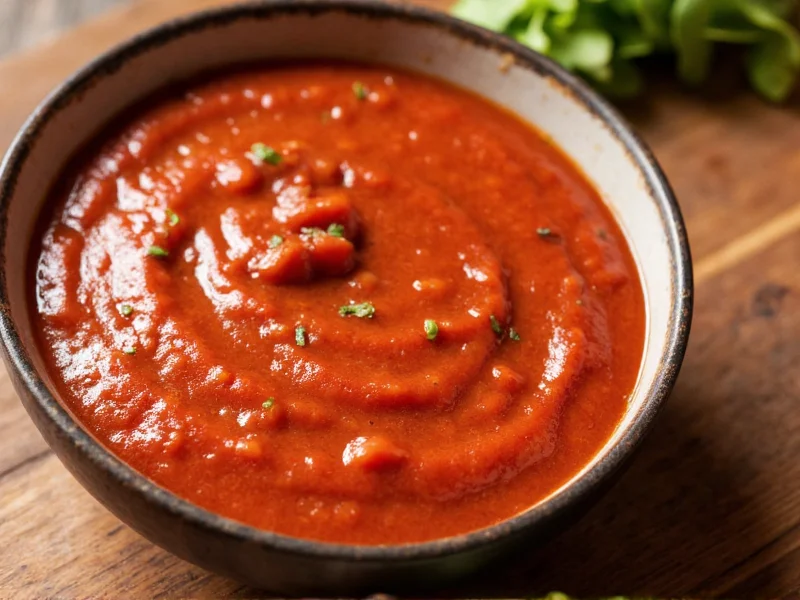Understanding Pepper-Based Sauces in Mexican Cuisine
When exploring authentic Mexican cooking, you'll quickly discover that pepper-based sauces form the foundation of flavor in countless dishes. These sauces, primarily made from various chili peppers (chiles), transform simple ingredients into complex, vibrant meals. Unlike generic 'pepper' sauces in other cuisines, Mexican preparations specifically use chiles—the Spanish term for chili peppers—which provide distinctive heat levels and flavor profiles.
Essential Pepper-Based Mexican Sauces
Mexican cuisine features several fundamental pepper-based sauces, each with unique characteristics and culinary applications. Understanding these sauces helps home cooks and food enthusiasts authentically recreate traditional dishes.
Salsa Roja: The Red Foundation
Salsa roja, literally 'red sauce,' serves as the workhorse of Mexican kitchens. This cooked sauce typically combines tomatoes, onion, garlic, and red chiles like guajillo, árbol, or ancho. The chiles provide varying heat levels while contributing earthy, smoky, or fruity notes. Salsa roja appears in everything from huevos rancheros to enchiladas and serves as a base for more complex sauces.
Salsa Verde: The Tangy Green Alternative
Salsa verde ('green sauce') offers a brighter, more acidic profile thanks to its primary ingredient: tomatillos. Combined with serrano or jalapeño peppers, cilantro, and onion, this uncooked sauce delivers a fresh, tangy heat perfect for tacos, chilaquiles, and as a finishing touch on cooked dishes. The tomatillo's natural pectin creates a distinctive texture that sets it apart from tomato-based salsas.
Adobo Sauce: The Smoky Preserving Liquid
Adobo sauce represents one of the most versatile pepper-based preparations in Mexican cooking. This rich, brick-red sauce features smoked jalapeños (chipotles), vinegar, garlic, and spices. Originally developed as a preservation method, adobo sauce now appears in countless recipes. You'll find it accompanying chipotle peppers in cans, used as a marinade for meats, or incorporated into stews and braises. Its complex flavor profile—smoky, tangy, and moderately spicy—makes it indispensable for authentic Mexican flavors.
Mole: The Complex Masterpiece
While not exclusively pepper-based, mole deserves mention as Mexico's most celebrated sauce. Traditional mole poblano combines multiple chiles (ancho, mulato, pasilla) with chocolate, spices, and nuts to create a complex, nuanced sauce. The chiles provide the essential heat foundation that balances the other ingredients. Mole's preparation often involves toasting and grinding ingredients separately before slow-cooking—a technique that develops its signature depth of flavor.
| Sauce Type | Primary Peppers | Preparation Method | Common Dishes |
|---|---|---|---|
| Salsa Roja | Guajillo, Árbol, Ancho | Cooked tomatoes and peppers | Enchiladas, Huevos Rancheros, Tacos |
| Salsa Verde | Serrano, Jalapeño | Raw tomatillos and peppers | Chilaquiles, Tacos, Quesadillas |
| Adobo Sauce | Chipotle (smoked jalapeño) | Simmered with vinegar and spices | Moles, Stews, Marinades, Tacos |
| Mole Poblano | Ancho, Mulato, Pasilla | Complex slow-cooked preparation | Chicken Mole, Turkey Mole |
Regional Variations Across Mexico
Mexican pepper-based sauces vary significantly by region, reflecting local ingredients and traditions. In Oaxaca, you'll find seven distinct moles, each with unique chile combinations. The Yucatán Peninsula features habanero-based sauces with tropical fruit additions. Northern Mexico favors simpler salsas with fresh chiles, while central regions develop more complex cooked sauces. Understanding these regional differences helps identify authentic preparations versus Americanized interpretations.
Traditional Preparation Techniques
Authentic Mexican pepper-based sauces follow specific preparation methods that maximize flavor development:
- Dry roasting chiles - Toasting dried chiles on a comal (griddle) enhances their natural sugars and develops complex flavors
- Rehydration process - Soaking dried chiles in hot water before blending creates smoother textures
- Separate cooking - Many traditional recipes cook each component separately before combining
- Stone grinding - Using a molcajete (mortar and pestle) creates superior texture compared to blenders
Modern Applications and Substitutions
While traditional preparation methods yield the best results, modern cooks often need practical adaptations. When authentic chiles aren't available, understanding flavor profiles helps with substitutions. Ancho chiles (mild, fruity) can sometimes substitute for guajillo (medium heat, berry notes), though the flavor profile will differ. For authentic adobo sauce flavor without specialty ingredients, combining smoked paprika with regular chili powder can approximate the smokiness of chipotles.
Preserving Authentic Flavor Profiles
Maintaining authentic flavor in pepper-based Mexican sauces requires attention to detail:
- Use ripe, quality chiles—fresh or dried—as the foundation of flavor
- Balancing acidity with natural ingredients like tomatillos or lime juice
- Controlling heat levels by adjusting seed content in fresh chiles
- Allowing proper resting time for flavors to meld after preparation











 浙公网安备
33010002000092号
浙公网安备
33010002000092号 浙B2-20120091-4
浙B2-20120091-4